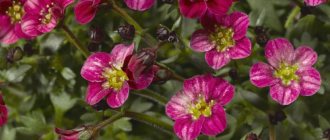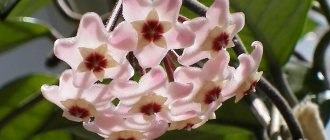This plant (Saxifraga indoor) is designed for real housewives who simply don’t want to bother with any flowers anymore, but want their home to be beautiful and cozy for the whole family.
Saxifraga has the ability to be very thick, such a flower can fit into any interior. You can also grow saxifraga in the garden in the open air and open ground; this flower is capable of growing in all weather conditions that exist on the planet; naturally, the winter and autumn periods are not included in this case, unless of course your Saxifraga grows outside.
To be brief, the blooming saxifrage is considered the most amazing and delightful flower.
Let us show you and tell you more about Saxifraga (saxifrage) and explain to you how to care for this plant at home. Flower lovers of the Russian Federation mainly appreciate the yellow Saxifraga, because of this the general emphasis will be on this variety of Saxifragaceae.
Description
Saxifraga is the most numerous genus (about 400 species) of the Saxifraga family.
In natural conditions, they prefer to settle in rock cracks, which is why they got their name (Saxifragaceae: saxum - rock, fragere - to break). These are perennial, less often annual, biennial herbaceous plants, with small leaves collected in rosettes. Saxifragas are typical inhabitants of alpine ecosystems. About 80 species grow in Russia.
The leaves are rounded with carved edges, often pubescent, with a silvery or reddish vein pattern. The stems are succulent, forming creeping shoots-stolons, at the ends of which new rosettes develop. Small inconspicuous flowers, light yellow or pinkish, are collected in racemose inflorescences on peduncle shoots. Saxifraga can be arranged as an ampel or a “waterfall” can be created on a shelf using stolon shoots rooted in the underlying pots.
One common species in indoor plant culture is Saxifraga.
Many species of the genus Saxifraga are used in rock gardens to create a moss carpet or border.
The leaves are widely used in folk medicine.
According to some beliefs, Saxifraga was considered a tear-grass that opens locks and breaks iron. They purify the air and improve the indoor microclimate.
Growing and care
Saxifraga is not very demanding; you can grow indoor saxifrage at home, but it grows better in open ground. The requirements and care of saxifrage differ by species, so before purchasing seeds or seedlings you need to familiarize yourself with the needs of the species and provide the plant with conditions that are as close to optimal as possible. It is important to provide permeable soil and a quiet place.
Other questions are very variable and require individual adjustment depending on the species, for example they may differ:
- soil fertility,
- humidity,
- amount of sunlight
- frost resistance.
Planting and care in open ground
In natural areas, saxifrage roots penetrate small cracks and cracks in search of moisture and soil. Therefore, the soil in rocky gardens should be well-drained with crushed stone, gravel or expanded clay. Planting saxifrage in spaces between flat, oblique stones, with drainage, gives good results. This plant does not need too fertile soil, so fertilizer is not required.
Most saxifrages are suited to a southeast or southwest position. It is better to choose shaded positions at least during the hottest afternoon hours. A good neighbor would be a rock fragment, a stone, or a root.
Worth knowing! Varieties with small, stiff, silvery leaves tolerate more sunlight than plants with soft, lush green rosettes that have low light requirements.
Some types of saxifrage require seed stratification before sowing. It was experimentally found that for better germination, the seeds of Saxifraga paniculata need to be cooled for 5 weeks at 3 °C; the treatment ensures about 90% germination. The use of the method accelerates germination by approximately 6-8 times compared to unstratified seeds.
The variety of species allows you to select varieties that prefer dry, rocky growing positions or swampy areas, for which the soil must be fertile, humus, and sufficiently moist.
Saxifraga, characteristic of high mountain regions in the Himalayas or Pyrenees, grows on highly drained soil. However, many species prefer richer and more humid places, and therefore require humus soils that are sufficiently moist and permeable.
Therefore, you first need to find out the requirements of a particular species, and only then, if they meet the conditions in the garden, buy seeds. There is no point in buying plants without basic knowledge in this area.
Wintering
Saxifragas in the mountains under a thick and dry blanket of snow are able to survive frosts below -20 ° C; in the lowlands they die during snowless and rainy winters. Therefore, rockeries need to be protected from excess autumn and winter precipitation.
Saxifragas are grown mainly in rocky gardens - rockeries, alpine hills, in quiet places protected from winter winds. In winter, plants are hidden under a thick layer of snow. But in open spaces during snowless winters, saxifrages have no chance of surviving in such extreme conditions.
For the winter, saxifrage should be protected from windy weather (for example, by the branches of coniferous plants), as well as from excessive humidity. In the latter case, ordinary window glass is suitable, which will protect against excessive rainfall in winter. Film roofs can also be installed. Some more sensitive species are grown in pots.
Diseases and pests
Saxifragas are not susceptible to diseases and pests, but suffer due to inadequate position and care, and poor wintering.
- Dying of the middle portions of the cushions is usually caused by over-compaction. Dividing into smaller fragments rejuvenates the plant and has a good effect on flowering.
- Another reason for the death of entire pillows may be ants trying to build nests in them, or aphids feeding at the roots. The presence of these pests is often reported to us by birds (blackbirds and starlings) pecking at pillows in search of insects. As a precaution, saxifrage should be treated 2-3 times with a diluted insecticide (for example, against aphids) in the middle of each season. Aerosol preparations should not be used as they will settle on the leaves.
Below are the most interesting species and features of their planting and cultivation.
Secrets of success
Saxifragas are fairly unpretentious plants. They do well at room temperature and moderate lighting. The plant needs to be watered generously with soft water during the growing season and somewhat less in winter.
Twice a month from May to November, mineral fertilizers should be applied during watering. Inspect the plant regularly, especially in winter, to promptly identify pests. When wiping the leaves from dust, you should be careful: you can easily damage the hairs. It is better to use a soft brush or brush.
Saxifraga (Saxifraga): the birthplace of the plant
This plant came to us from the mountainous areas of the Northern Hemisphere. There it was first discovered by biologists in the crevices of rocks, hence the name of this flower. Saxifraga moss seems to break stones and grow inside them. Initially it was a wild plant, and then over time it began to be domesticated. Now it grows both in the garden and at home.
It does not require special care and tolerates both heat and cold. It is also unpretentious in nutrition and does not require frequent feeding. This plant can serve as an excellent decoration both at home and in the garden, because the saxifrage plant is very beautiful. It originally covered mountains and rocks with a beautiful carpet. Now it can decorate any balcony or window in a city apartment.
Varieties of saxifrage
This plant has many species, but in indoor floriculture, the most famous is the wattled saxifrage, or shoot-bearing, or shoot-forming saxifrage. This is a perennial. The height of this type of saxifrage is small. The leaves of this plant species are round, slightly convex and collected in a basal rosette. Their diameter does not exceed 7 cm.
The color of the leaves of this plant is green with white veins on the surface, and the leaves below have a reddish tint. Both sides of the leaf are covered with tiny hairs, and it is rough to the touch. The petioles of this species of saxifrage are quite long, covered with hairs and have a reddish tint. There is also a variegated form of this type of saxifrage. It's three colors. The leaves of this species of saxifrage are red-green-white or green-pink-white.
This plant should definitely be hung on a carnation in a pot, as it sends out so-called lashes in the form of twigs with new children at the end of the plant. This plant usually blooms in spring and summer. The shape of the flowers resembles a star and their color is white. The peduncle is very tall and reaches a length of even 30 cm, despite the fact that the leaves themselves seem to spread along the surface of the earth. After such a saxifrage stops blooming, it begins to lose its former beauty and may even die altogether.
In addition to the wattled saxifrage, there are the following types:
- Saxifraga paniculata;
- Sizolistnaya or in other words cesium;
- Stiffleaf;
- Opposite foliage;
- Stupid leaf;
- Hawkleaf;
- Soddy (especially beautiful are the varieties Purpurmantelle and Rosa-königen);
- Mossy (varieties such as Snow and Purple Mantle are especially common);
- Round-leaved;
- Paniculata (good for a rock garden or alpine slide);
- Juniperus foliage;
- Tongue;
- Manchurian saxifrage;
- Shadow;
- Pink saxifrage;
- Polar;
- Yellow;
- Grainy;
- Bolotnaya (on the verge of extinction);
- Wedge-leaved;
- Urban saxifrage;
- Alpine saxifrage;
- Narrow-leaved;
- Cartilaginous;
- Hosta;
- Siberian;
- Musk;
- Petroragia;
- Inlaid saxifrage;
- Cortusfolia;
- Variegata;
- Anders;
- Variegated.
You can plant a mixture of varieties in one place or in one pot at home. Believe me, it looks very beautiful, especially when the plant blooms. These, so to speak, gems will give your garden or home a special zest.
Planting and propagation of saxifrage
Saxifraga propagates by seeds and cuttings. The easiest way is to place pots of soil mixture next to the mother plant and place rosettes in the center of the pots. Compact the soil and water well. After new leaves appear at the rosette, cut off the tendrils of the mother plant.
Saxifraga is very easy to propagate using rosettes from the mother bush.
Saxifraga requires low-nutrient, humus soil. A clay-turf mixture is suitable. The pot is chosen to be flat and shallow, expanded clay is placed on the bottom as drainage, and soil is placed on top.
Attention. Saxifraga has medicinal properties. The juice of the leaves and a decoction from the plant is used for purulent skin lesions and as a means to lower the temperature.
Plant properties
Saxifraga shady variegata
Almost all types of saxifrage from the garden have medicinal properties; everything useful for the human body is found in the leaf blades:
- alkaloids
- flavonoids
- organic acids
- vitamins
- fatty acid
These substances have antitumor, antihemorrhoidal, and antiseptic properties. The decoction calms exacerbation of asthma, relieves symptoms of vomiting and infectious diseases, inflammation of the genitourinary system and liver. Fresh leaves will alleviate the condition and help eliminate purulent rashes on the skin.
You can use saxifrage as a medicine only after consulting with a specialist; uncontrolled use can negatively affect human health.
Kinds
Saxifraga stolonifera
Another name is saxifrage (Saxifraga sarmetosa). In nature, common in the mountains of Japan and China. This species is a herbaceous perennial. It grows up to 0.5 m in height. The shoots are red and thin. The leaves grow in rosettes, the leaf shape is round, the base is heart-shaped, the edges of the leaves are crenate-lobed; the upper side of the leaf blade is green with white veins, and the lower side is red; leaves are pubescent. Saxifraga blooms from late spring to late summer; flowers with red or white petals are collected in clusters.
Diseases and pests
Plant requiring attention
All varieties and types of saxifrage are characterized by increased resistance to many diseases and plant pests.
But sometimes, under certain circumstances, the trunk can be affected:
- fungal diseases
- root rot
- powdery mildew
- mealybug
- spider mite
- aphids
Root rot is a consequence of fungal diseases that occur as a result of improper watering or poor soil drainage . The methods of combating these diseases are drastic; diseased plants, along with their rhizomes, are removed from the flowerbed. The vacated space must be treated with fungicides and the soil replaced.
How to prepare medicine from saxifraga yourself?
To prepare an excellent painkiller at home, you will need to take 20 grams of fresh saxifrage herb (Saxifraga) and pour 300 grams of boiling water over it. Then you need to let it stand covered for about 20 minutes, and then cool and strain. Next, you should add enough boiled water to the potion so that its volume is equal to 300 grams. And you need to take this home remedy 2 tablespoons four times a day at the time you eat, or after eating it.
If you suffer from otitis media, then in this case you can squeeze the juice from the saxifrage leaves, dip a cotton swab in it and place it in the auricle. After the tampon has been in the ear for a couple of hours, it can be removed and then made fresh. This procedure must be carried out until complete recovery.
If you suffer from high blood pressure, then saxifrage (Saxifraga) will also come to your aid. In this case, you will need to take half a glass of fresh crushed leaves, pour 0.5 liters of vodka over them and leave for two weeks. You will need to shake this tincture every day. After 14 days have passed, the leaves need to be squeezed out, and the finished medicine should be taken 1 teaspoon diluted with 20 ml of clean water. The medicine should be taken twice a day, 20 minutes before meals.
Medicinal properties of yellow saxifrage
Now you know how to plant saxifraga, let’s now talk about its beneficial properties. The fact is that this plant is widely used in medicine and some medications and tablets are produced from it. Such a drug, for example, is “Chanca Piedra”. This name comes from the Amazon, because that’s what they call saxifrage there. This drug is produced in the form of capsules containing saxifraga extract. And it is used to treat various diseases of the genitourinary system. By the way, it helps very well against gallstones. But before using it, you must consult a doctor.
Yellow saxifrage leaves are used as medicinal raw materials. Even if you pick them all from this plant, it will not die and will give new leaves over time, you won’t have to wait long for this. The leaves should be dried in a well-ventilated area at a constant air temperature. The air humidity in the room in which you will dry the plant should not be high, otherwise the drying process will take more time and generally the result may be a low-quality medicinal product.
Saxifraga Arends
In addition to diseases of the genitourinary system, the following diseases can be cured with the help of saxifraga:
- Hypertension;
- Otitis;
- Severe headache or toothache.
Growing from seeds
Now we want to talk in detail about how to grow saxifrage from seeds. This will come in handy if no one in your immediate environment has this plant. You can buy seeds at any flower shop. So, you need to sow yellow saxifrage in the spring, around April or late March. To sow seeds, you will need to prepare the soil. It should be quite fertile. Scatter the seeds over the surface of the soil and press lightly with your hands so that they disappear into the ground. You should not plant this plant deep so that you do not have to wait long for germination.
Saxifraga Arends
As soon as the yellow saxifraga sprouts (and this will happen in about a month and a half), it needs to be planted in small pots. Even yogurt cups are suitable for this. And at the beginning of summer it will be possible to place the seedlings in a permanent place in your garden. We described how to do this correctly just above. You can also sow the seeds directly into open ground, but this can only be done in the summer, when the ground has warmed up sufficiently, or you can cover the planted seeds with a special covering material for stratification.
Signs associated with saxifrage
Many people grow yellow saxifrage in their garden, on their balcony or on the windowsill of their apartment, but few people think about its impact on its owner. So, it is believed that this flower appears in the house as a sign of something bad, and if you get it, then trouble will definitely overtake the owners. In some rural settlements, where black magic is common, saxifrage is given to one's enemies with the aim of sending misfortune to their home.
But we hasten to inform you that these are just superstitions, and you should not take them seriously. After all, if a person constantly thinks that something very bad will happen to him, then this will certainly happen. Therefore, we advise you to think positively and grow flowers that you have a passion for and that you really like. Flowers grow well in homes where there is love and respect for each other.
It's all about saxifrage. Now you know what types and varieties this plant comes in, you know how to properly care for it and propagate it, and you can also use this unusual flower to get rid of some diseases. But remember that you should never self-medicate, which means that you should definitely consult a general practitioner regarding home remedies for saxifrage.











